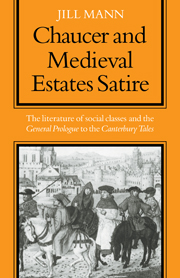Book contents
- Frontmatter
- Contents
- Preface
- List of Abbreviations
- Note on References
- 1 Introduction
- 2 The Anti-Clerical Tradition in Estates Satire
- 3 Estates Ideals
- 4 The Omission of the Victim
- 5 Independent Traditions: Chivalry and Anti-Feminism
- 6 Descriptive Traditions: Beauty and the Beast
- 7 ‘Scientific’ Portraits
- 8 New Creations
- Excursus: The ‘General Prologue’ and the ‘Descriptio’ Tradition
- 9 Conclusions
- Appendices
- Notes
- Selected Bibliography and List of Works Cited
- Index
2 - The Anti-Clerical Tradition in Estates Satire
Published online by Cambridge University Press: 23 October 2009
- Frontmatter
- Contents
- Preface
- List of Abbreviations
- Note on References
- 1 Introduction
- 2 The Anti-Clerical Tradition in Estates Satire
- 3 Estates Ideals
- 4 The Omission of the Victim
- 5 Independent Traditions: Chivalry and Anti-Feminism
- 6 Descriptive Traditions: Beauty and the Beast
- 7 ‘Scientific’ Portraits
- 8 New Creations
- Excursus: The ‘General Prologue’ and the ‘Descriptio’ Tradition
- 9 Conclusions
- Appendices
- Notes
- Selected Bibliography and List of Works Cited
- Index
Summary
A traditional estates content is most easily recognisable in the portraits of the Monk and the Friar, both of them figures with a long literary history. The different ranks of the clergy are the estates most frequently and fully treated by satirists, and it is therefore significant that the clerical figures are also among the most fully described of the Canterbury pilgrims. Far from drawing new inspiration from real life, Chaucer seems to have been most stimulated by the possibility of exploiting a rich literary tradition.
The estates treatments of monks and friars will conveniently illustrate the diverse features of character and behaviour associated with these classes, and also the way in which these diverse details are coherently linked with a unified stereotype, sometimes presented as a personification or typical figure (‘Religioun’, ‘monachus’, ‘frater’) which could be animated as an individual person. They also illustrate the variety of style in estates literature, the sophisticated handling of raillery, irony and word-play whose relationship with Chaucer is not one of simple inferiority.
THE MONK
The Monk's portrait suggests examination of the following features of the monastic stereotype: a love of good food, luxurious clothing, a love of horses and hunting, contempt for patristic and monastic authority, laziness, a refusal to stay within cloister walls, the temptations of holding various monastic offices.
- Type
- Chapter
- Information
- Chaucer and Medieval Estates Satire , pp. 17 - 54Publisher: Cambridge University PressPrint publication year: 1973
- 1
- Cited by



